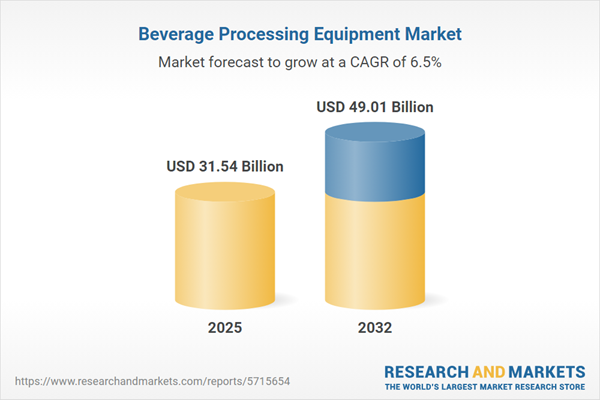Speak directly to the analyst to clarify any post sales queries you may have.
The beverage processing equipment market is experiencing pivotal transformation as senior leaders integrate digitalization, respond to evolving regulations, and rethink supply chain models to maintain competitiveness and agility.
Beverage Processing Equipment Market Snapshot
In 2024, the global beverage processing equipment market achieved a value of USD 29.61 billion. This sector is projected to expand to USD 31.54 billion by 2025 and reach USD 49.01 billion by 2032, supported by a robust compound annual growth rate (CAGR) of 6.49%. Growth is driven by continuous modernization in production facilities, heightened regulatory oversight, and a market shift toward consumer-driven, innovative beverage products. Stakeholders are increasingly committed to adopting smarter automation, advancing sustainable practices, and aligning capacity with real-time market demands to secure a resilient competitive posture.
Scope & Segmentation: Beverage Processing Equipment Market
This report delivers comprehensive analysis tailored for executive decision-makers, offering clarity on operational risks, market opportunities, and strategic direction. Segmentation enables relevant benchmarking and strategic resource alignment:
- Product Type: Assesses specialized solutions for processing alcoholic beverages, dairy products, juices, soft drinks, and water—helping organizations select equipment optimized for diverse beverage segments.
- Equipment Type: Explores technologies spanning cleaning, sterilization, aseptic packaging, heat treatments (including pasteurization and UHT), and advanced blending, mixing, and separation.
- Power Supply: Reviews electric, gas, steam, and hybrid system capabilities, addressing energy efficiency goals and compliance with varying plant infrastructures.
- Capacity: Highlights scalable solutions, suitable for both high-volume enterprise operations and niche, lower-volume beverage manufacturers looking for flexibility and cost effectiveness.
- End User: Details equipment demands of commercial breweries, dairies, juice and soft drink makers, and wineries, helping optimize fit and operational efficiency.
- Regional Coverage: Covers North America, South America, Europe, Middle East, Africa, and Asia-Pacific, enabling informed responses to regulatory, infrastructural, and expansion challenges unique to each area.
- Leading Companies: Features profiles of top industry suppliers, identifying current technology adoption, supply chain enhancements, and adaptive strategies shaping the sector’s evolving dynamics.
This structured segmentation supports executive teams in identifying high-impact investment opportunities and operational improvements in fast-changing market environments.
Beverage Processing Equipment Market: Key Takeaways
- Automation and Industrial Internet of Things (IIoT) technologies are empowering manufacturers with real-time production insights, contributing to smarter decision-making and process refinements across beverage processing operations.
- Stricter environmental regulations motivate a shift toward energy- and water-efficient equipment, with sustainable packaging solutions increasingly prioritized to reduce environmental impact.
- Flexible and modular machinery enables rapid adaptation of production lines and agile product reformulation, helping organizations respond more quickly to shifting market preferences and reduce risks associated with delayed launches.
- Technology adoption varies by region: European operators focus on carbon reduction, Middle Eastern companies prioritize water management, while Asia-Pacific manufacturers emphasize facility modernization for increased throughput and quality.
- Strategic alliances and partnerships among producers and suppliers are advancing digital capabilities and enabling improved customer service models throughout the value chain.
- Better data platforms and improved lifecycle management practices support regulatory compliance, drive predictive equipment maintenance, and increase post-sale value for customers acquiring processing systems.
Tariff Impact and Supply Chain Dynamics
With new U.S. tariffs imminent in 2025, input costs for specialty materials used in beverage processing equipment are expected to rise, directly impacting supplier choices and sourcing strategies. Manufacturers are expanding their supplier bases and forging regional partnerships to maintain operational reliability. Nearshoring activities are intensifying, boosting transparency throughout the supply chain and introducing fresh operational efficiency expectations. These shifts are also prompting companies to re-evaluate their financial structures and capitalization strategies to withstand ongoing trade complexities and pricing volatility in the sector.
Methodology & Data Sources
This report utilizes direct interviews with C-suite and supply chain leaders, along with technical specialists, as well as supplementary research from industry publications and regulatory documents. Market forecasts and risk assessments are constructed through scenario planning leveraging SWOT and PESTEL frameworks.
Why This Report Matters: Beverage Processing Equipment Market
- Enables senior leadership to benchmark technology adoption and steer investment strategies aligned with corporate sustainability and resilience priorities.
- Offers segmented analysis and regulatory perspectives to streamline resource planning, risk mitigation, and support for both international and regional growth strategies.
- Provides procurement and executive teams with supplier evaluation tools, helping to elevate sourcing quality and enhance overall competitive positioning.
Conclusion
This report empowers executive teams to confidently navigate operational complexities, enabling sustainable growth and greater organizational agility as the beverage processing equipment market continues to evolve.
Additional Product Information:
- Purchase of this report includes 1 year online access with quarterly updates.
- This report can be updated on request. Please contact our Customer Experience team using the Ask a Question widget on our website.
Table of Contents
3. Executive Summary
4. Market Overview
7. Cumulative Impact of Artificial Intelligence 2025
List of Figures
Samples

LOADING...
Companies Mentioned
The key companies profiled in this Beverage Processing Equipment market report include:- Tetra Laval International S.A.
- GEA Group Aktiengesellschaft
- Krones Aktiengesellschaft
- Alfa Laval Corporate AB
- SPX FLOW, Inc.
- SIG Combibloc Group AG
- John Bean Technologies Corporation
- KHS GmbH
- Bucher Industries AG
- IMA S.p.A
Table Information
| Report Attribute | Details |
|---|---|
| No. of Pages | 180 |
| Published | October 2025 |
| Forecast Period | 2025 - 2032 |
| Estimated Market Value ( USD | $ 31.54 Billion |
| Forecasted Market Value ( USD | $ 49.01 Billion |
| Compound Annual Growth Rate | 6.4% |
| Regions Covered | Global |
| No. of Companies Mentioned | 11 |









